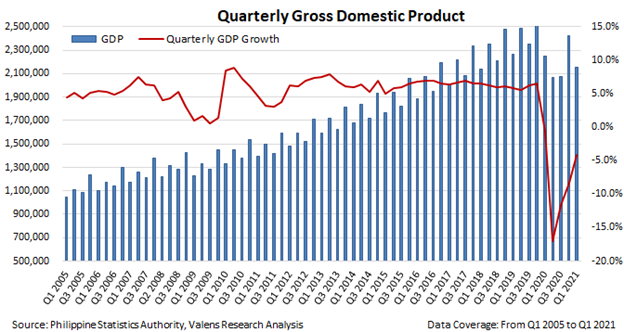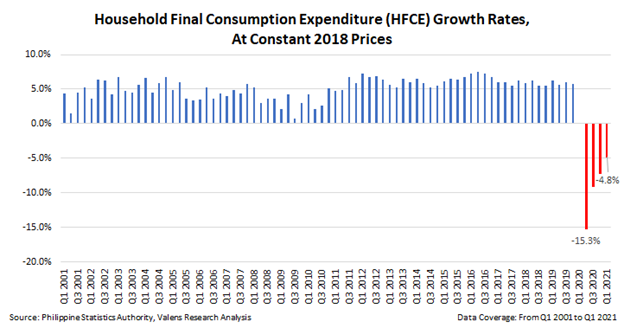MONDAY MACRO: With a slower contraction, improvements to this metric is trending toward economic recovery

When people talk about how the Philippine economy is doing, they usually think about the Philippine GDP. Despite its limitations, it is still one of the most common indicators to determine a country’s economic performance.
Today, we feature one of the components of the Philippine economy and understand how it continues to drive the Philippine economy.
Philippine Markets Daily:
The Monday Macro Report
Powered by Valens Research
In the 1930s, the term gross domestic product (GDP) was introduced as a value to integrate the economic production of all individuals, companies, and the government into one measurement.
By representing the finished goods and services produced within a country, the GDP became a decent measurement to indicate a contracting or expanding economy.
In theory, an expanding economy is related to a rising GDP. This is because more businesses would have been able to capitalize on the healthy demand for finished goods and services.
Furthermore, the improving business environment may help attract local and international investors to conduct or expand businesses in the country. This is why a rising GDP will commonly result in more employment opportunities as well as higher aggregate wages going forward.
On the other hand, a shrinking GDP shows a struggling economy. When a country’s GDP shrinks for two quarters in a row, that means the country has technically entered a recession.
This consecutive decline in economic activity has been the case in the Philippines since Q2 2020 as a result of the pandemic. As of Q1 2021, the Philippine GDP has shrunk for the fifth consecutive quarter.
Recording a 4.2% contraction in Q1 2021, the GDP, though not growing, has been shrinking less since its 17% decline in Q2 2020.

Even though the government has stepped up its efforts to support and stimulate more economic activity through government spending and lower interest rates, this has not been enough to spur economic growth.
To understand what is driving this decline, we need to understand first what comprises this measurement.
GDP is calculated as the sum of the country’s consumer spending, corporate investments, government spending, and exports deducted by imports (or net exports).
Although all factors are important, some have more impact over others depending on the country’s major industries. For the Philippines, accounting for more than 70% of the country’s GDP is the Household Final Consumption Expenditure (HFCE), or consumer spending.

Prior to 2020, HFCE growth rates have been positive but volatile. At constant 2018 prices, HFCE reached its lowest growth rate of 0.8% in Q3 2008-2009 due to the impact of the global financial crisis. It reached its highest growth rate in Q2 2015-2016 at 7.5%. On average, consumer spending has been growing by 4.4% a year since 2001.
However, because of the lockdowns that began in March 2020, HFCE improved by only 0.2% in Q1 2020 compared to a year ago, then fell to its lowest with a record 15% shrinkage in Q2 2020. market selloff caused by the pandemic, recording a 12% loss that matched its benchmark’s 12% loss.
Though still in negative territory, consumer spending has been shrinking at slower rates, at a 4.8% contraction in Q1 2021. This is also the trend we see for GDP growth.
In the past, OFW remittances had been the driving force for the Philippines’ household consumption spending, and so slightly lower remittances in 2020-2021 immediately translated to lower consumer spending felt in the country’s GDP growth rate.
Going forward, downward pressure on the GDP growth rates will continue mainly because quarantine restrictions prevent consumers from fully spending at pre-pandemic levels. However, the improving HFCE growth rates are a good sign for the Philippine economy.
About the Philippine Markets Daily
“The Monday Macro Report”
When just about anyone can post just about anything online, it gets increasingly difficult for an individual investor to sift through the plethora of information available.
Investors need a tool that will help them cut through any biased or misleading information and dive straight into reliable and useful data.
Every Monday, we publish an interesting chart on the Philippine economy and stock market. We highlight data that investors would normally look at, but through the lens of Uniform Accounting, a powerful tool that gets investors closer to understanding the economic reality of firms.
Understanding what kind of market we are in, what leading indicators we should be looking at, and what market expectations are, will make investing a less monumental task than finding a needle in a haystack.
Hope you’ve found this week’s macro chart interesting and insightful.
Stay tuned for next week’s Monday Macro report!
Regards,
Angelica Lim
Research Director
Philippine Markets Daily
Powered by Valens Research
www.valens-research.com




